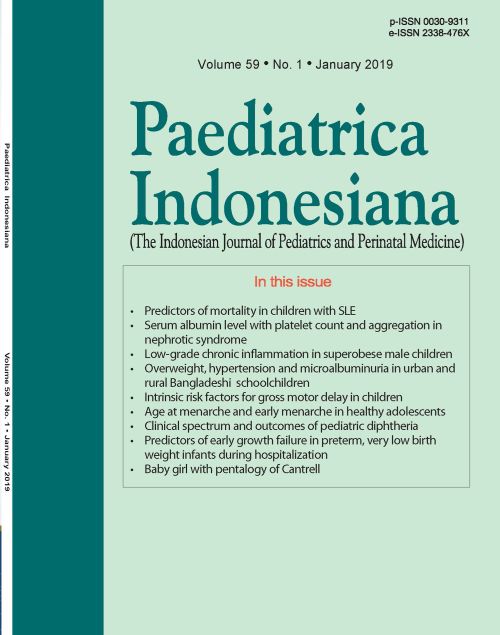Intrinsic risk factors for gross motor delay in children aged 6-24 months
Abstract
Background. Gross motor is one of the skill domain with the highest parental concern as mastering it determines the autonomy of a child. Several internal risk factors including perinatal asphyxia, prematurity, low birth weight, wide fontanelle, and microcephaly have been studied in predicting gross motor delay with varied results. This study is made to arrange a strategic intervention on the prevention of delayed development.
Objective. To evaluate perinatal asphyxia, gestation age <37 weeks, birth weight <2500 grams, microcephaly, and wide fontanelle as predictors of gross motor delay in children aged 6-24 months.
Methods. A case control study design was used. Data collection was conducted by direct assessment of gross motor skill and parents’ interview in Cipto Mangunkusumo National Hospital and Anakku Clinic, South Jakarta. Children with gross motor delay were included in the case group and children with normal gross motor were included in the control group. Data was analyzed using bivariate and multivariate analysis with a statistical significance value of P<0.05 and 95% confidence intervals.
Results. One hundred and twenty-six subjects were studied, with 63 children in the case group and 63 children in the control group. Baseline characteristics of subjects were similar between the two groups. Microcephaly and gestation age <37 weeks were predictors of gross motor delay [(aOR 4.613 (95% CI 95 2.023 to 10.521, P<0.001) and (aOR 3.668 (95% CI 1.153 to 11.673, P=0.028), respectively].
Conclusion. Microcephaly and gestation age <37 weeks are significant predictors of gross motor delay in children aged 6-24 months.
References
Kliegman RM, Stanton BF, Geme III JWS, Schor NF. Nelson Textbook of Pediatrics. 20th ed. Philadelphia: Elsevier Saunders; 2016. p. 65-70.
Payne VG, Isaacs LD. Human motor development: a lifespan approach. 8th ed. New York: The McGraw-Hill; 2012. p. 2-28. PMid:23107509
Ribeiro C da C, Pachelli MR de O, Amaral NC de O, Lamonica DAC. Development skills of children born premature with low and very low birth weight. CoDAS. 2017;29:1–6.
Cleary MA. A Developmental delay: when to suspect and how to investigate for an inborn error of metabolism. Archives of Disease in Childhood. 2005;90:1128–32. https://doi.org/10.1136/adc.2005.072025 PMid:16243864 PMCid:PMC1720165
Cusick S, Georgieff MK. The first 1,000 days of life: The brain's window of opportunity [Internet]. UNICEF-IRC. [cited 2017 Dec 1]. Available from: https://www.unicef-irc.org/article/958/.
Marcdante KJ, Kliegman RM. Nelson essentials of pediatrics. 7th ed. Philadelphia: Elsevier Saunders; 2015. p. 15-6.
Cutland CL, Lackritz EM, Mallet-Moore T, Bardaji A, Chandrasekaran R, Lahariya C. Low birth weight: case definition & guidelines for data collection, analysis, and presentation of maternal immunization safety data. Vaccine. 2017;35:6492–500. https://doi.org/10.1016/j.vaccine.2017.01.049 PMid:29150054 PMCid:PMC5710991
Preterm birth [Internet]. World Health Organization. [cited 2018 Nov 1]. Available from: http://www.who.int/news-room/fact-sheets/detail/preterm-birth.
Uswatun A, Wulandari A. Hubungan lingkar kepala dengan perkembangan anak usia 12-24 bulan di Posyandu Tlogowatu Kemalang Klaten. Involusi Jurnal Ilmu Kebidanan. 2011;1:37–44.
Esmaeili M, Esmaeili M, Ghane Sharbaf F, Bokharaie S. Fontanel size from birth to 24 months of age in Iranian children. Iran J Child Neurol. 2015;9:15–23. PMid:26664437 PMCid:PMC4670973
Gordon-Lipkin E, Genter MBG, German R, Leppert ML. Neurodevelopmental outcomes in 22 children with microcephaly of different etiologies. J Child Neurol. 2017;32(9):804-9. https://doi.org/10.1177/0883073817707301 PMid:28482742
Scharf RJ, Stroustrup A, Conaway MR, DeBoer MD. Growth and development in children born very low birthweight. Arch Dis Child Fetal Neonatal Ed. 2016;101:433–8. https://doi.org/10.1136/archdischild-2015-309427 PMid:26627552 PMCid:PMC5494252
Moura DR, Costa JC, Santos IS, Barros AJD, Matijasevich A, Halpem R. Risk factors for suspected developmental delay at age 2 years in a brazilian birth cohort. Pediatr Perinat Epidemiol. 2010;24:211–21. https://doi.org/10.1111/j.1365-3016.2010.01115.x PMid:20415750 PMCid:PMC3500503
Bang K. Analysis of risk factors in children with suspected developemental delays on the denver developmental screening test. Korean Acad Child Health Nurs. 2008;14:261–8.
Kerstjens JM, de Winter A, Tjeertes I, Bos AF, Reijneveld S. Risks of developmental delay increases exponentially as gestational age of preterm infants decreases: a cohort study at age 4 years. Developmental Medicine and Child Neurology. 2012;54:1096–101. https://doi.org/10.1111/j.1469-8749.2012.04423.x PMid:23020259
Arumsari DR, Faizi M. Faktor Risiko yang berhubungan dengan keterlambatan perkembangan global pada balita. Program Studi Pendidik Bidan Fak Kedokt Univ Airlangga Surabaya. 2013.
Copyright (c) 2019 Joanna Erin Hanrahan, Irawan Mangunatmadja

This work is licensed under a Creative Commons Attribution-NonCommercial-ShareAlike 4.0 International License.
Authors who publish with this journal agree to the following terms:
Authors retain copyright and grant the journal right of first publication with the work simultaneously licensed under a Creative Commons Attribution License that allows others to share the work with an acknowledgement of the work's authorship and initial publication in this journal.
Authors are able to enter into separate, additional contractual arrangements for the non-exclusive distribution of the journal's published version of the work (e.g., post it to an institutional repository or publish it in a book), with an acknowledgement of its initial publication in this journal.
Accepted 2019-02-06
Published 2019-02-26













